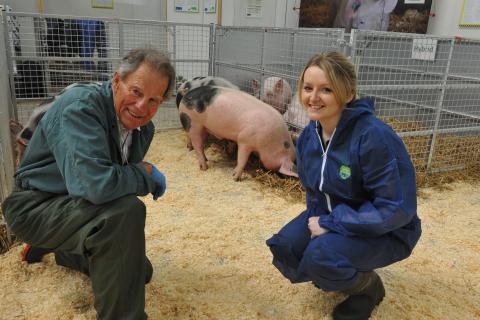4 June 2018
Wales’s prospective pigmeat producers are being urged to consider which market they intend to supply before establishing their herds.
With three very distinct pig types to choose from, each with desirable but different traits, specialist pig vet Bob Stevenson says target markets should dictate which of these new producers should stock their units with.
During a Farming Connect seminar at the Royal Welsh Spring Festival, Mr Stevenson said the hybrid, crossbred and purebred offered producers different opportunities.
“Don’t go into pigs unless you know what your market it,’’ Mr Stevenson warned. “Identify your market and select a breed to match that.’’
He suggested that pig production falls into three main categories – smallholders, large-scale commercial units and individuals who keep pigs as a hobby – with system type dictating which type to keep.
The hybrid, the most commonplace on UK pig farms, is a genetically improved pig which grows at 1kg a day. Breeds include an amalgamation of the Large White, Landrace and Duroc.
“These are the ultimate ‘supermarket’ pig,’’ said Mr Stevenson. “They are the fastest growing and the most efficient but not necessarily the tastiest.’’
The fast-growing crossbred, which includes the Pietrain, is bred for hybrid vigour and the meat is desired by independent butchers. With their double muscling, Mr Stevenson describes them as the Belgian Blues of the pig world.
The popularity in hybrid and crossbred pig breeds, due to their advantages of efficiency in their growth and feed conversion, has come at a cost to purebreds such as the Welsh Pig,
Numbers have plummeted in recent years but there is a gradual resurgence, prompted in part by the awarding of the European Commission’s Traditional Specialities Guaranteed (TSG) status to the breed last year.
Mr Stevenson said that purebreds were mostly concentrated in small, non-intensive herds and valued for their eating quality. Due to their slower growth and lack of hybrid vigour it is necessary for many producers to promote the distinctive qualities of the breed to add value to their produce.
“In the 1950s the then Department of Agriculture championed the Welsh Pig together with the Large White and the Landrace. They valued it and that is still the case,’’ he said.
The Welsh Pig, used within the seminar as an example of purebred pigs, produce good-size litters – an average of 11 piglets born alive. “The sows have good mothering ability because they are selected for 14 teats,’’ said Mr Stevenson.
In his opinion, the Welsh Pig is superior for taste, succulence and cookability offering a unique selling point when seeking a market.
“The Welsh Pig grows well and is very useful for commercial production as well as preserving the breed. It adds up to lovely combination of a native breed that people want to preserve and one that has a commercial application.’’
Jodie Roberts, Pigs and Poultry Technical Officer at Farming Connect, said the message from the seminar was clear – each pig type has its own advantages.
“Which type you choose ultimately comes down to what you are intending to do with it, there is no one size that fits all,’’ she said.
This project is co-ordinated by Farming Connect which is funded by the European Agricultural Fund for Rural Development and the Welsh Government.

